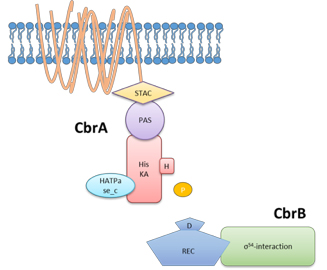Structure and function of SSSF-related sensor kinases in Pseudomonas
Pseudomonas putida is a soil bacterium and colonizes the root system of plants. Establishment and maintenance of contacts of the cell with other organisms require transmembrane signal transduction. In this context, we are studying a new type of putative sensor kinase/response regulator (SK/RR) systems of P. putida that is characterized by a sensor kinase containing a N-terminal domain similar to members of the sodium/solute symporter family (SSSF, e.g., PutP, PanF) at the primary and secondary structure level, and a C-terminal domain sharing homology to histidine kinases (e.g., NtrB). Research is focused on the SK/RR-system CbrA/CbrB (PP4695/PP4696) of P. putida KT2440 that is involved in regulation of C-source utilization.
Domain structures of CbrA and CbrB

